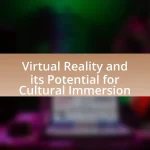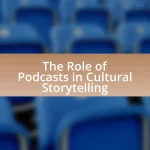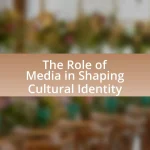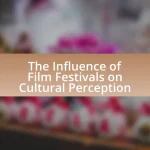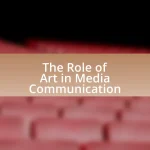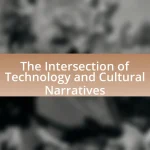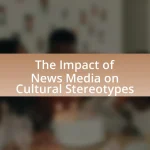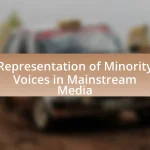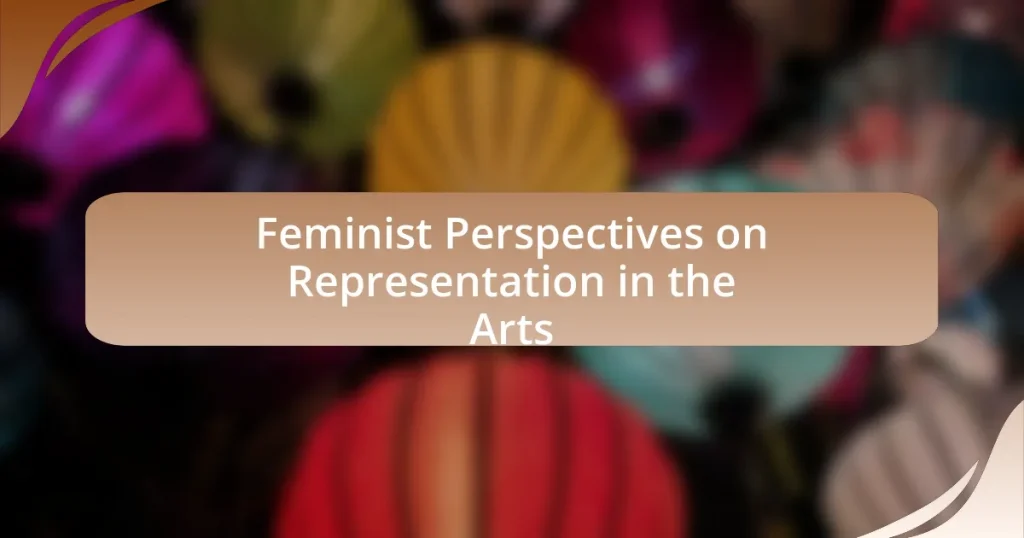Feminist perspectives on representation in the arts focus on the necessity for diverse and equitable portrayals of women and marginalized genders, challenging traditional narratives that often exclude or misrepresent them. The article examines how feminist theories influence artistic representation by critiquing male-dominated narratives and advocating for the inclusion of women’s experiences. It discusses key feminist theories relevant to the arts, such as feminist aesthetics and intersectionality, and highlights the historical context that has shaped these perspectives. Additionally, the article addresses contemporary challenges, current debates, and strategies for enhancing feminist representation in various art forms, emphasizing the importance of inclusivity in fostering societal change.
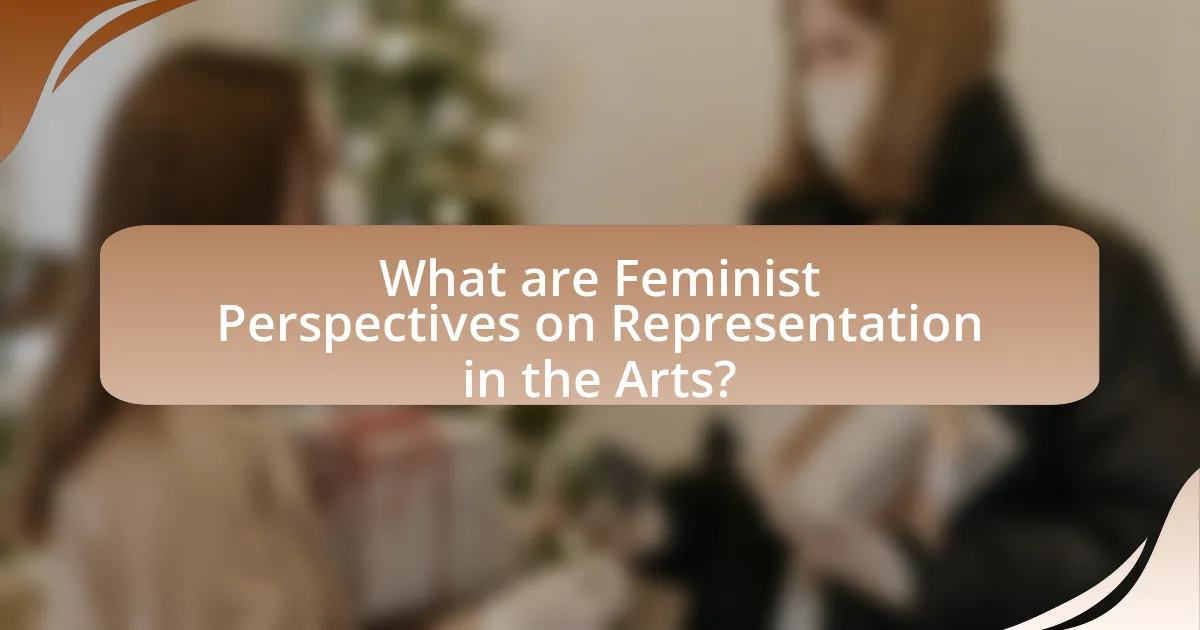
What are Feminist Perspectives on Representation in the Arts?
Feminist perspectives on representation in the arts emphasize the need for diverse and equitable portrayals of women and marginalized genders, challenging traditional narratives that often exclude or misrepresent them. These perspectives argue that art reflects and shapes societal values, thus advocating for the inclusion of women’s voices and experiences in artistic expression. Historical movements, such as the Women’s Liberation Movement, have highlighted the underrepresentation of women in various art forms, leading to initiatives that promote female artists and critique gender biases in art institutions. Research by scholars like Linda Nochlin has examined the systemic barriers women face in the art world, reinforcing the argument for feminist interventions to create a more inclusive artistic landscape.
How do feminist theories influence artistic representation?
Feminist theories significantly influence artistic representation by challenging traditional gender roles and advocating for the inclusion of women’s perspectives in art. These theories critique the male-dominated narratives that have historically shaped artistic expression, promoting works that reflect women’s experiences and identities. For instance, artists like Judy Chicago and Cindy Sherman utilize their art to confront societal norms and highlight issues such as gender inequality and objectification. Research indicates that feminist art movements have led to increased visibility of female artists and a broader understanding of gender in art, as seen in exhibitions like “WACK! Art and the Feminist Revolution,” which showcased the contributions of women artists from the 1970s onward. This shift not only diversifies artistic representation but also encourages a reevaluation of the cultural significance of women’s roles in society.
What key feminist theories are relevant to the arts?
Key feminist theories relevant to the arts include feminist aesthetics, intersectionality, and the male gaze. Feminist aesthetics critiques traditional art standards and emphasizes women’s experiences and perspectives in artistic expression. Intersectionality, introduced by Kimberlé Crenshaw, examines how overlapping social identities, such as race and gender, influence the representation and experiences of women in the arts. The concept of the male gaze, articulated by Laura Mulvey, analyzes how visual arts often depict women from a male perspective, objectifying them and reinforcing patriarchal norms. These theories collectively challenge existing power dynamics and advocate for more inclusive representations in the arts.
How do these theories challenge traditional representations?
Feminist theories challenge traditional representations by critiquing the male-dominated narratives and stereotypes prevalent in art and media. These theories argue that traditional representations often marginalize women’s experiences and perspectives, reinforcing gender biases. For instance, feminist art movements, such as those in the 1970s, sought to reclaim women’s voices by highlighting female artists and their unique viewpoints, thereby disrupting the conventional portrayal of women as passive subjects. This shift is evidenced by the increased visibility of female artists in galleries and exhibitions, which historically favored male artists, thus validating the need for diverse representations in the arts.
Why is representation important in the arts?
Representation is important in the arts because it ensures diverse voices and experiences are acknowledged and reflected, fostering inclusivity and understanding. When various identities, particularly those historically marginalized, are represented, it challenges stereotypes and promotes social change. For instance, research by the Geena Davis Institute on Gender in Media found that female characters in film and television are often underrepresented, which can influence societal perceptions of gender roles. By increasing representation, the arts can empower individuals, validate their experiences, and contribute to a more equitable society.
What impact does representation have on societal views?
Representation significantly shapes societal views by influencing perceptions of identity, culture, and social norms. When diverse groups are accurately portrayed in the arts, it fosters understanding and empathy, leading to more inclusive societal attitudes. For instance, research by the Geena Davis Institute on Gender in Media found that female characters in film and television can impact young girls’ aspirations and self-image, demonstrating that representation can alter societal expectations and norms regarding gender roles. Furthermore, studies indicate that increased visibility of marginalized communities in media correlates with greater acceptance and support for those groups, highlighting the critical role representation plays in shaping societal views.
How does representation affect marginalized groups?
Representation significantly affects marginalized groups by shaping societal perceptions and influencing their access to opportunities. When marginalized groups are accurately represented in the arts, it fosters a sense of belonging and validation, which can enhance their self-esteem and identity. Conversely, lack of representation can perpetuate stereotypes and reinforce systemic inequalities. For instance, studies show that diverse representation in media leads to increased empathy and understanding among audiences, as seen in the success of films featuring underrepresented communities, which often result in higher box office revenues and critical acclaim. This illustrates that representation not only impacts the marginalized groups themselves but also influences broader societal attitudes and behaviors.
What historical context shapes feminist perspectives in the arts?
Feminist perspectives in the arts are shaped by historical contexts such as the women’s suffrage movement, the civil rights movement, and the rise of second-wave feminism in the 1960s and 1970s. These movements highlighted gender inequalities and challenged traditional representations of women in art, leading to a reevaluation of women’s roles both as subjects and creators. For instance, the establishment of feminist art collectives, like the Women’s Art Registry in the 1970s, sought to promote women’s contributions to the arts and critique the male-dominated art world. Additionally, landmark exhibitions, such as “Womanhouse” in 1972, showcased women’s experiences and perspectives, further solidifying the importance of feminist viewpoints in artistic expression.
How have women’s roles in the arts evolved over time?
Women’s roles in the arts have evolved significantly from being largely marginalized to gaining recognition and influence across various artistic disciplines. Historically, women were often excluded from formal artistic training and professional opportunities, limiting their visibility and contributions. However, the feminist movements of the 20th century catalyzed a shift, advocating for women’s rights and representation in the arts.
By the late 20th century, women began to emerge as prominent artists, curators, and critics, challenging traditional narratives and creating spaces for female voices. For instance, the establishment of organizations like the Women’s Caucus for Art in 1972 highlighted women’s contributions and addressed issues of gender inequality in the art world.
Today, women artists are celebrated for their diverse perspectives and innovative approaches, with increased visibility in galleries, museums, and art markets. Statistics show that female artists are now more frequently represented in major exhibitions and collections, reflecting a broader societal recognition of their contributions to the arts.
What significant movements have influenced feminist representation?
Significant movements that have influenced feminist representation include the suffrage movement, the women’s liberation movement, and intersectional feminism. The suffrage movement, which gained momentum in the late 19th and early 20th centuries, focused on women’s right to vote and laid the groundwork for future feminist activism. The women’s liberation movement of the 1960s and 1970s expanded the conversation to include issues such as reproductive rights, workplace equality, and sexual liberation, significantly shaping feminist representation in various media. Intersectional feminism, emerging in the late 20th century, emphasizes the importance of considering race, class, and other identities in feminist discourse, thereby enriching the representation of diverse women’s experiences in the arts. These movements collectively transformed societal perceptions and artistic expressions of femininity, leading to a more nuanced understanding of women’s roles and identities.
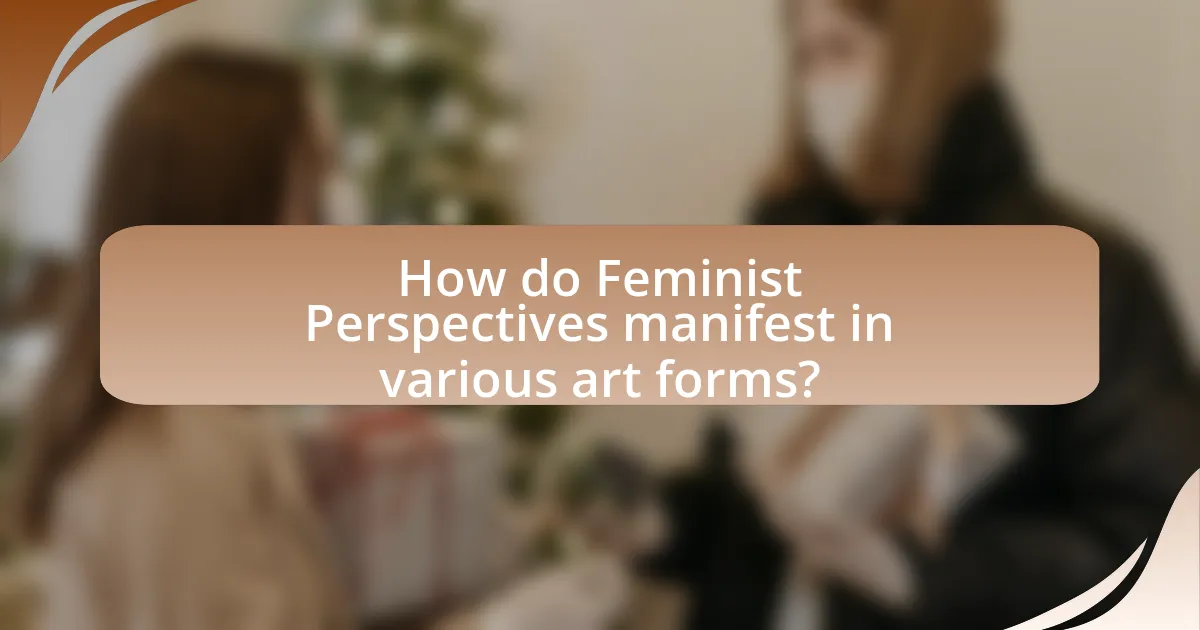
How do Feminist Perspectives manifest in various art forms?
Feminist perspectives manifest in various art forms through the exploration of gender roles, the critique of patriarchal structures, and the representation of women’s experiences. In visual arts, artists like Judy Chicago and Frida Kahlo challenge traditional representations of women, using their work to highlight female identity and personal narratives. In literature, authors such as Virginia Woolf and Toni Morrison address themes of gender inequality and the complexities of female existence, often employing innovative narrative techniques to convey their messages. In performance art, figures like Marina Abramović use their bodies to confront societal norms and provoke discussions about gender and power dynamics. These manifestations are supported by historical movements, such as the Women’s Liberation Movement, which has influenced artistic expression and the visibility of women’s voices in the arts.
What are the key art forms where feminist perspectives are evident?
Key art forms where feminist perspectives are evident include visual arts, literature, performance arts, and film. In visual arts, feminist artists like Judy Chicago and Cindy Sherman challenge traditional gender roles and representation. Literature has seen feminist themes in works by authors such as Virginia Woolf and Margaret Atwood, who explore women’s experiences and societal constraints. Performance arts, exemplified by artists like Marina Abramović, often address issues of identity and gender dynamics. In film, directors like Ava DuVernay and Greta Gerwig create narratives that highlight women’s stories and perspectives, contributing to a broader discourse on gender equality. These art forms collectively reflect and critique societal norms, making feminist perspectives a vital part of contemporary artistic expression.
How is feminist representation portrayed in visual arts?
Feminist representation in visual arts is portrayed through the exploration of women’s experiences, identities, and societal roles, often challenging traditional gender norms. Artists like Judy Chicago and Frida Kahlo utilize their work to highlight female empowerment and critique patriarchal structures. For instance, Chicago’s installation “The Dinner Party” features place settings for historical and mythical women, symbolizing their contributions and reclaiming their narratives. This approach not only elevates women’s voices but also encourages viewers to reconsider the representation of gender in art. The impact of feminist art movements since the 1970s has led to increased visibility and recognition of female artists, reshaping the art world to be more inclusive and reflective of diverse perspectives.
What role does feminist literature play in representation?
Feminist literature plays a crucial role in representation by challenging traditional narratives and amplifying women’s voices and experiences. This genre seeks to address and rectify the historical underrepresentation of women in literature and the arts, thereby reshaping societal perceptions of gender roles. For instance, works by authors such as Virginia Woolf and Toni Morrison not only highlight women’s struggles but also provide nuanced portrayals of female identity, contributing to a broader understanding of gender dynamics. Studies have shown that feminist literature increases visibility for marginalized groups, fostering a more inclusive cultural landscape.
How do feminist artists challenge conventional narratives?
Feminist artists challenge conventional narratives by subverting traditional representations of gender and identity in their work. They often critique the male-dominated art world and societal norms by creating pieces that highlight women’s experiences, perspectives, and histories. For instance, artists like Judy Chicago and Cindy Sherman use their art to confront stereotypes and question the roles assigned to women in both art and society. Chicago’s “The Dinner Party” serves as a feminist reinterpretation of historical narratives, celebrating women’s contributions to culture, while Sherman’s photography explores the construction of female identity in media. These approaches not only disrupt established narratives but also encourage viewers to reconsider the societal structures that shape perceptions of gender.
What techniques do feminist artists use to convey their messages?
Feminist artists use techniques such as subversion of traditional gender roles, incorporation of personal narratives, and the use of mixed media to convey their messages. By challenging established norms, feminist artists like Judy Chicago and Barbara Kruger create works that highlight women’s experiences and critique societal expectations. For instance, Chicago’s “The Dinner Party” employs a triangular table setting to symbolize women’s contributions to history, while Kruger’s text-based art juxtaposes images with provocative statements to question power dynamics. These methods effectively communicate feminist themes and engage audiences in critical dialogue about gender and representation.
How do feminist performances address issues of representation?
Feminist performances address issues of representation by challenging traditional narratives and highlighting marginalized voices. These performances often deconstruct gender roles and stereotypes, presenting alternative perspectives that reflect the complexities of women’s experiences. For instance, artists like Marina Abramović and Yoko Ono utilize their bodies as sites of resistance, confronting societal norms and advocating for visibility. Research indicates that feminist performance art has historically provided a platform for underrepresented groups, fostering dialogue around identity, power dynamics, and social justice. This approach not only critiques existing representations but also actively reshapes cultural discourse, making it more inclusive and reflective of diverse experiences.
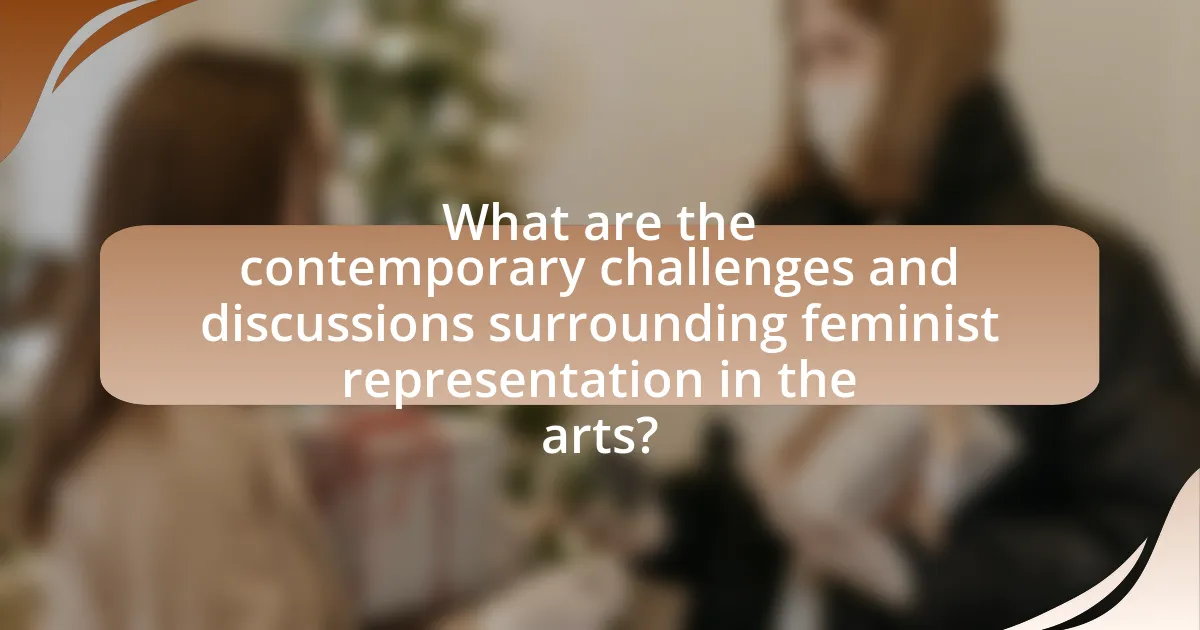
What are the contemporary challenges and discussions surrounding feminist representation in the arts?
Contemporary challenges surrounding feminist representation in the arts include underrepresentation of women artists, the persistence of gender stereotypes, and the need for intersectionality in feminist discourse. Women artists remain significantly underrepresented in galleries and exhibitions; for instance, a 2020 report by the National Museum of Women in the Arts found that only 11% of artists in major exhibitions were women. Additionally, discussions focus on how traditional narratives often reinforce gender stereotypes, limiting the portrayal of women’s experiences. The call for intersectionality emphasizes the importance of including diverse voices, particularly those of women of color and LGBTQ+ individuals, to create a more inclusive representation in the arts. These challenges highlight the ongoing need for advocacy and systemic change within the art world.
What current debates exist regarding representation in the arts?
Current debates regarding representation in the arts focus on issues of gender, race, and sexuality, emphasizing the need for diverse voices and perspectives. Advocates argue that traditional narratives often marginalize women and minority groups, leading to calls for increased visibility and inclusion in artistic spaces. For instance, the #MeToo movement has highlighted the underrepresentation of women in leadership roles within the arts, prompting discussions about equity in funding and opportunities. Additionally, debates surrounding the portrayal of race in visual arts and literature challenge artists to confront stereotypes and promote authentic representation. These discussions are supported by statistics showing that women and people of color remain significantly underrepresented in major art institutions and exhibitions, underscoring the urgency for systemic change.
How do intersectionality and diversity influence feminist representation?
Intersectionality and diversity significantly influence feminist representation by highlighting the varied experiences and identities of women, which leads to a more inclusive portrayal in the arts. Intersectionality, a concept introduced by Kimberlé Crenshaw, emphasizes that women’s experiences are shaped by multiple factors such as race, class, sexuality, and ability, thus challenging the notion of a singular feminist narrative. This understanding encourages artists and creators to represent a broader spectrum of women’s voices and experiences, moving beyond traditional, often Eurocentric, depictions. For instance, the inclusion of diverse narratives in feminist art movements, such as the work of artists like Faith Ringgold and Frida Kahlo, illustrates how intersectional perspectives can enrich feminist representation by addressing issues of race, gender, and cultural identity. Consequently, this approach fosters a more nuanced understanding of feminism, allowing for a richer dialogue about women’s roles and experiences in society.
What criticisms do feminist perspectives face in the arts today?
Feminist perspectives in the arts today face criticisms primarily for being perceived as exclusionary and overly focused on gender, which some argue limits broader discussions of intersectionality. Critics contend that these perspectives often prioritize women’s experiences to the detriment of other marginalized identities, thereby failing to address the complexities of race, class, and sexuality within artistic representation. For instance, scholars like bell hooks have highlighted that feminist art movements can sometimes overlook the contributions and experiences of women of color, leading to a narrow understanding of feminism in the arts. Additionally, some argue that feminist critiques can be seen as divisive, creating a backlash against feminist artists and their work, as evidenced by the ongoing debates surrounding the representation of women in major art institutions and exhibitions.
How can artists and audiences promote better representation?
Artists and audiences can promote better representation by actively advocating for diverse voices and perspectives in artistic works. Artists can create inclusive content that reflects a variety of experiences, while audiences can support and uplift underrepresented artists by attending their events, sharing their work, and demanding more equitable representation in mainstream platforms. Research indicates that diverse representation in the arts not only enriches cultural narratives but also fosters empathy and understanding among audiences, as highlighted in the study “The Impact of Diversity in the Arts” by the National Endowment for the Arts. This collaborative effort between artists and audiences can lead to a more equitable and representative artistic landscape.
What strategies can be employed to enhance feminist representation in the arts?
To enhance feminist representation in the arts, strategies such as increasing funding for women artists, promoting gender parity in exhibitions, and implementing educational programs focused on feminist art history can be employed. Increasing funding specifically targets the financial barriers that women artists face, as studies show that women receive significantly less funding than their male counterparts. Promoting gender parity in exhibitions addresses the historical underrepresentation of women in galleries and museums, with data indicating that only 27% of artists in major exhibitions are women. Educational programs can raise awareness and appreciation for feminist art, fostering a new generation of artists and audiences who value diverse perspectives.
How can education and advocacy improve awareness of feminist perspectives?
Education and advocacy can significantly improve awareness of feminist perspectives by providing structured knowledge and fostering critical discussions about gender equality and representation. Educational programs that include feminist theory and history enable individuals to understand the systemic issues women face in various fields, including the arts. For instance, courses that analyze the representation of women in art history reveal biases and encourage a reevaluation of traditional narratives. Advocacy efforts, such as campaigns and public discussions, raise visibility for feminist issues, mobilizing communities to challenge stereotypes and support equitable representation. Research shows that increased exposure to feminist content in educational settings correlates with heightened awareness and support for gender equality initiatives, as evidenced by studies conducted by the American Association of University Women, which highlight the positive impact of educational interventions on attitudes toward gender issues.
